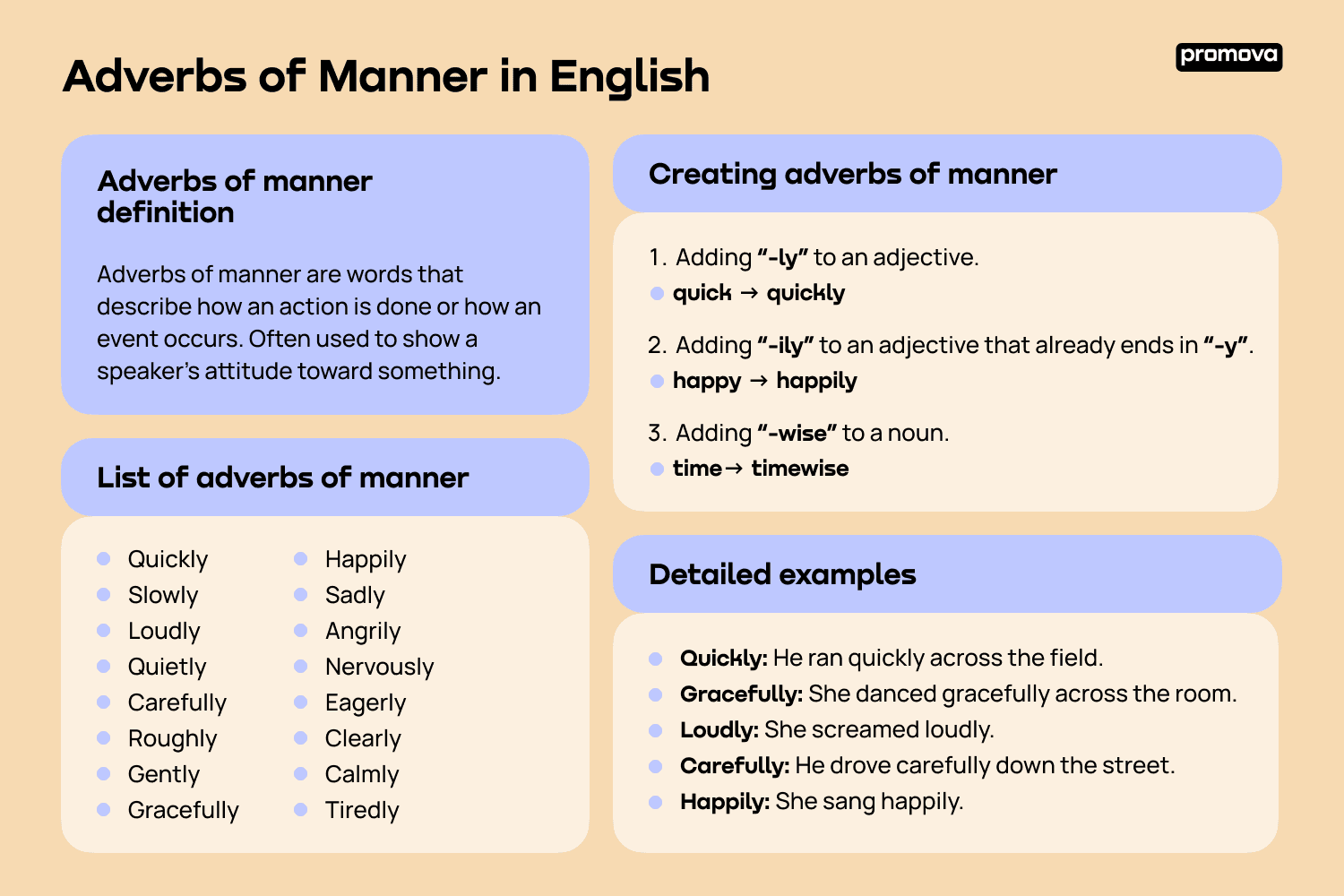Adverbs of manner in English
Contents
Adverbs are words that help us understand how something is done. They're incredibly common and we use them to describe how events happen. We use them to make sentences more interesting and give readers a better understanding of what is being said.
In this reference, you will learn all about adverb telling manner, how to use adverbs in sentences, and discover a list of handy examples.
Adverbs of manner definition
Adverbs of manner are words that describe how an action is done or how an event occurs. They are usually placed after the verb or immediately after the object. These adverbs can also be placed at the beginning or end of your sentence for emphasis. Adverbs of manner can also help modify adjectives or other adverbs.
These adverbs add details to a sentence and can make it more descriptive. They help to paint a vivid picture of what is being said. For example, someone might say, “She walked slowly down the street.” The adverb “slowly” gives us an idea of how she was walking.
Manner adverbs are often used to show a speaker’s attitude toward something. For example, “She said sarcastically” reveals the speaker’s attitude towards what was said. Or, “He said happily” reveals his attitude towards the situation.
Detailed examples of adverbs of manner
Adverbs of manner can be used to add details to sentences and make them more interesting.
Common examples of adverbs of manner:
- Quickly: He ran quickly across the field.
- Gracefully: She danced gracefully across the room.
- Loudly: She screamed loudly.
- Carefully: He drove carefully down the street.
- Happily: She sang happily.
- Sadly: He said sadly.
- Angrily: He shouted angrily.
- Nervously: She laughed nervously.
- Eagerly: He waited eagerly for her response.
As you can see, these adverbs are very versatile and common in everyday life.
How to use manner adverbs in sentences
Adverbs of manner can be used in different ways. They can be used to describe how someone does something or how something happens or to emphasize a point or to add detail to a sentence.
When using adverbs of manner, it is important to remember to place them in the correct place in the sentence. Generally, they should be placed directly after the verb or after the object of the verb.
For example, in the sentence “She sang happily”, the adverb “happily” is placed after the verb “sang”.
It is also important to avoid using too many adverbs of manner in a sentence. Too many adverbs can make a sentence sound awkward and cluttered. For example, the sentence “She sang happily, joyfully, and gleefully” is too wordy and does not sound natural.
1
List of adverbs of manner
Here are some common adverbs of manner:
- Quickly
- Slowly
- Loudly
- Quietly
- Carefully
- Roughly
- Gently
- Gracefully
- Happily
- Sadly
- Angrily
- Nervously
- Eagerly
- Clearly
- Calmly
- Tiredly
- Determinedly
- Confidently
- Boldly
- Cheerfully
- Sadly
- Energetically
Creating adverbs of manner
These adverbs are usually created by adding -ly to an adjective. For example, the adjective “quick” becomes the adverb “quickly”. Other examples include “eager” becoming “eagerly” and “loud” becoming “loudly”.
Some are created by adding -ily to an adjective that already ends in -y. For example, "happy" becomes "happily" and "angry" becomes “angrily.”
You can also create adverbs of manner by adding -wise to a noun. For example, the noun “time” becomes the adverb “timewise” and the noun “price” becomes the adverb “pricewise”. It's a bit rarer to see these types of adverbs, but they can be incredibly useful to help you sound fluent.

Summary
Adverbs of manner are words that describe how an action is done or how an event occurs. They can be used to make sentences more interesting and give readers a better understanding of what is being said.
When using adverbs of manner, it is important to remember to place them in the correct place in the sentence. Generally, they should be placed directly after the verb or after the object of the verb. It is also important to avoid using too many adverbs of manner in a sentence.
Adverbs of manner are a great way to add detail to sentences and make them more interesting. Over time, you'll be able to naturally add them to your speech and even create your own.



Comments